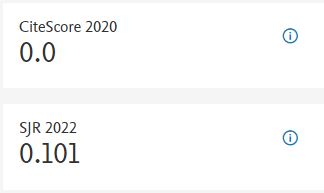Empirical Analysis of Factors Affecting Switching Behaviour of Banking Customers
DOI:
https://doi.org/10.7492/e0djn123Keywords:
Factors, Bank, Switching, Intentions, Customer, Behaviour, Financial, Technology, ServiceAbstract
The banking industry is witnessing a transformative era with respect to the advancement in technology as well as development of an interconnected world, playing a crucial role in changing the very existing banking perspective. As financial institutions incorporate diverse innovative methods of technology and policies in engaging with the customers, switching banks has become a crucial factor of concern for the financial institutions affecting their financial health. There exist multifaceted factors that influence in shaping the customer’s intention towards switching from one bank to another. These factors that range from technological adoption, pricing, quality of services to user convenience, perceived ease of use and customer satisfaction play pivotal role in enhancing customer loyalty which further takes part in decision-making of customers regarding staying or leaving their banks. As the banking landscape continues to evolve, understanding these factors have become crucial for developing strategic measures that help in building a transparent, empathetic, responsive, and efficient banking system facilitating towards high quality customer experience and satisfaction. By analyzing multitude of factors that play major role in determining customer’s switching intention, the study contribute towards strengthening a better financial ecosystem that work towards improving commitment and customer loyalty through a trustworthy financial ecosystem. The study had considered a sample of 263 bank customers to determine the factors that affect the switching behavior of banking customers and impact of different factors on switching behavior of banking customers. Exploratory Factor Analysis (EFA) and Multiple Regression were used to analyze the data. It was found that Service Quality, Fees and Costs, Convenience, Trust and Reputation and Product Offerings shown positively impact on switching behavior of banking customers.
The banking industry is witnessing a transformative era with respect to the advancement in technology as well as development of an interconnected world, playing a crucial role in changing the very existing banking perspective. As financial institutions incorporate diverse innovative methods of technology and policies in engaging with the customers, switching banks has become a crucial factor of concern for the financial institutions affecting their financial health. There exist multifaceted factors that influence in shaping the customer’s intention towards switching from one bank to another. These factors that range from technological adoption, pricing, quality of services to user convenience, perceived ease of use and customer satisfaction play pivotal role in enhancing customer loyalty which further takes part in decision-making of customers regarding staying or leaving their banks. As the banking landscape continues to evolve, understanding these factors have become crucial for developing strategic measures that help in building a transparent, empathetic, responsive, and efficient banking system facilitating towards high quality customer experience and satisfaction. By analyzing multitude of factors that play major role in determining customer’s switching intention, the study contribute towards strengthening a better financial ecosystem that work towards improving commitment and customer loyalty through a trustworthy financial ecosystem. The study had considered a sample of 263 bank customers to determine the factors that affect the switching behavior of banking customers and impact of different factors on switching behavior of banking customers. Exploratory Factor Analysis (EFA) and Multiple Regression were used to analyze the data. It was found that Service Quality, Fees and Costs, Convenience, Trust and Reputation and Product Offerings shown positively impact on switching behavior of banking customers.
References
Agarwal, P. K. (2019). Drivers of bank/branch switching intentional behaviour in retail banking: Evidence from Indian banking customers. Marketing and Consumer Research, 54, 2422-8451.
Al-Hawari, M. (2006). The effect of automated service quality on bank financial performance and the mediating role of customer retention. Journal of Financial Services Marketing, 10(3), 228-243.
Altwijry, O. I., & Abduh, M. (2013). Customer satisfaction and switching behavior in Saudi Islamic banks: An exploratory study. Journal of Islamic Finance, 2(2).
Bhatnagar, S. B., Mishra, J. K., & Syed, A. A. (2019). Customer disloyalty in retail banking services: attitudinal and behavioural dimensions. Asia-Pacific Journal of Business Administration, 11(1), 46-67.
Burmeister, E., & Aitken, L. M. (2012). Sample size: how many is enough? Australian critical care: official journal of the Confederation of Australian Critical Care Nurses, 25(4), 271–274. https://doi.org/10.1016/j.aucc.2012.07.002
Chawla, D., Sondhi, N. (2011). Research Methodology: Concepts and Cases, Vikas Publishing House Pvt. Ltd, New Delhi, India.
Chiguvi, D., &Guruwo, P. T. (2017). Impact of customer satisfaction on customer loyalty in the banking sector. International Journal of Scientific Engineering and Research (IJSER), 5(2), 55-63.
Cohen, D. A., Gan, C., Hwa, A., & Chong, E. Y. (2006). Customer satisfaction: a study of bank customer retention in New Zealand.
Fahmi, S., & Rohman, F. (2018). Factors affecting Indonesian consumers to switch, using mobile banking and internet banking service. KnE Social Sciences.
Farah, M. F. (2017). Application of the theory of planned behavior to customer switching intentions in the context of bank consolidations. International Journal of Bank Marketing, 35(1), 147-172.
Farah, M. F. (2017). Consumers’ switching motivations and intention in the case of bank mergers: a cross-cultural study. International Journal of Bank Marketing, 35(2), 254-274.
Fernández-Gutiérrez, M., & Ashton, J. (2023). “One size doesn't fit all”. Bank switching decisions and customer vulnerability in Europe. International Journal of Bank Marketing.
Ghouri, A. M., Khan, N. U., Siddqui, U. A., Shaikh, A., & Alam, I. (2010). Determinants analysis of customer switching behavior in private banking sector of Pakistan. Interdisciplinary Journal of Contemporary Research in Business, 2(7), 96-110.
Green, S.B. (1991). How many subjects does it take to do a regression analysis? Multivariate Behavioral Research, 1991, 26, 499-510
Hair, J. F., Black, W. C., Babin, B. J., Anderson, R. E., & Tatham, R. L. (2006). Multivariate data analysis 6th Edition. Pearson Prentice Hall. New Jersey. humans: Critique and reformulation. Journal of Abnormal Psychology, 87, 49-74.
Inakura, N., &Shimizutani, S. (2010). Deposit insurance and depositor discipline: direct evidence on bank switching behaviour in Japan. Applied Economics, 42(26), 3401-3415.
Karimii, O., Maymand, M. M., Hosseini, M. H., & Ahmadinejad, M. (2012). Customer switching behavior: developing model in the Iranian retail banking industry. Journal of Financial Services Marketing, 17(2), 341-366.
Kaur, G., Sharma, R. D., & Mahajan, N. (2014). Segmentation of bank customers by loyalty and switching intentions. Vikalpa, 39(4), 75-90.
Khanna, V., & Sharma, R. (2017). Consumer switching behaviour in banking sector in India. International Journal of Applied Business and Economic Research, 15(9), 427-441.
Koutsothanassi, E., Bouranta, N., & Psomas, E. (2017). Examining the relationships among service features, customer loyalty and switching barriers in the Greek banking sector. International Journal of Quality and Service Sciences, 9(3/4), 425-440.
Lymperopoulos, C., Chaniotakis, I. E., &Soureli, M. (2013). The role of price satisfaction in managing customer relationships: the case of financial services. Marketing Intelligence & Planning, 31(3), 216-228.
Malhotra, N. K. (2007). Marketing research: An applied orientation. Upper Saddle River, NJ: Pearson/Prentice Hall.
Mehta, K., Sharma, R., & Khanna, V. (2023). Customer switching behaviour in Indian retail banking using logit regression. International Journal of Business Excellence, 29(4), 518-545.
Munir, S., Majeed, M. I., Parvaiz, A. N., Imtiaz, M., & Mobeen, M. M. (2022). Impact of Security, Reputation, Service Quality, Advertising, Involuntary Switch and Customer Service on Customer Switching Behaviour in the Banking Sector of Pakistan.
Murungu, F. (2013). Customers’ switching behavior on banking Performance: a case of national bank of Commerce Morogoro (Doctoral dissertation).
Narteh, B. (2013). Key determinant factors for retail bank switching in Ghana. International Journal of Emerging Markets, 8(4), 409-427.
Ngau, C. M., Zins, A. H., &Rengasamy, D. (2023). Why do bank customers switch? A systematic literature reviews. International Journal of Bank Marketing.
Nimako, S. G., & Winneba, K. G. (2012). Consumer switching behaviour: a theoretical review and research agenda. Research Journal of Social Science and Management, 2(3), 74-85.
Nyarko, I. K. (2015). Evaluation of factors influencing switching behaviour by Ghana commercial bank customers. British Journal of Marketing Studies, 3(8), 35-46.
Piha, L. P., &Avlonitis, G. J. (2015). Customer defection in retail banking: Attitudinal and behavioural consequences of failed service quality. Journal of Service Theory and Practice, 25(3), 304-326.
Sivakumaran, V., & Peter, S. (2020). Model to assess consumer switching behaviour. In Proceedings of the International Conference on Industrial Engineering and Operations Management (pp. 10-12).
Stewart, K., & McCabe, E. (2006). The ‘Net Effect ‘on Bank Customer Complaining Behaviour. The Marketing Review, 6(1), 41-53.
Subramaniam, R., & Ramachandran, J. (2012). Customers’ switching behavior in banking industry empirical evidence from Malaysia. International Journal of Business, Economics and Law, 1(7).
Tanuwijaya, E., & Oktavia, T. (2023). Analysis of the Factors Influencing Customer Switching Behaviour of Millennials in Digital Banks. Journal of System and Management Sciences, 13(2), 122-133.
Tesfom, G., & Birch, N. J. (2011). Do switching barriers in the retail banking industry influence bank customers in different age groups differently? Journal of Services Marketing, 25(5), 371-380.
Van der Cruijsen, C., &Diepstraten, M. (2017). Banking products: you can take them with you, so why don’t you? Journal of Financial Services Research, 52, 123-154.
Vyas, V., &Raitani, S. (2014). Drivers of customers’ switching behaviour in Indian banking industry. International Journal of Bank Marketing, 32(4), 321-342.
Wagle, A. R. (2019). Determinants of Customer Switching Behaviour in Banking Sector of Nepal (Doctoral dissertation, Department of Management).
Wahyudi, R. (2017). Customers’ Switching Behavior in Banking in The Special Region of Yogyakarta Province Indonesia. JurnalMasharif al-Syariah: JurnalEkonomidanPerbankanSyariah, 2(2).
Wang, L., Luo, X. R., Yang, X., & Qiao, Z. (2019). Easy come or easy go? Empirical evidence on switching behaviors in mobile payment applications. Information & Management, 56(7), 103150.
Wong, H. S., Wong, R. K., & Leung, S. (2019). Enhancing sustainability in the banking industry: factors affecting customer loyalty. Academy of accounting and financial studies journal, 23(3), 1-12.
Zhang, D. (2009). Customer switching behaviour in the Chinese retail banking industry (Doctoral dissertation, Lincoln University).
Zhao, C., Noman, A. H. M., &Asiaei, K. (2022). Exploring the reasons for bank-switching behavior in retail banking. International Journal of Bank Marketing, 40(2), 242-262.
Zhao, C., Noman, A. H. M., & Hassan, M. K. (2023). Bank's service failures and bank customers' switching behavior: does bank reputation matter? International Journal of Bank Marketing, 41(3), 550-571.
Zhou, T. (2018). Examining users' switch from online banking to mobile banking. International Journal of Networking and Virtual Organizations, 18(1), 51-66.
Zikienė, K., & Bakanauskas, A. P. (2009). Research of factors influencing loyal customer switching behaviour. Management of Organizations: Systematic Research, 52.

















